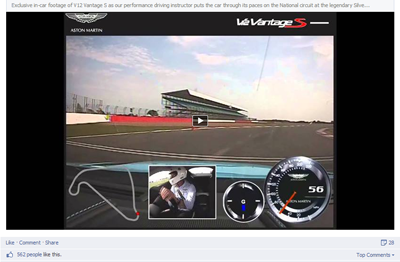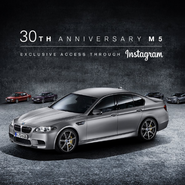Automotive brands have embraced social media at a higher rate than brands in other product categories, according to a report from L2.
Average community growth for auto brands on Instagram jumped 152 percent, and the platform generates an average engagement level of 2.68 percent. While communities on other platforms have grown at similar rates, the second highest average engagement level is .21 percent on Pinterest.
"In terms of engagement, Instagram is the clear winner, registering 30 times the engagement found on more mature social platforms," said Colin Gilbert, research director of the report, New York.
"The visual impact of auto collateral and the diversity of photographs sourced from ads, trade shows, racing sports, and user-generated content helps brands establish diverse content feeds," he said.
"This stands in stark contrast to other sectors that recycle images without an eye toward curation. As a result, select brands such as BMW, Mercedes-Benz, and Audi are hitting the 1 million follower milestone on global accounts, while actively expanding additional accounts that cater to local audiences."
L2′s “Digital IQ Index: Auto” assesses the digital proficiency of 42 automotive brands. Rankings were devised according to the following criteria: 30 percent Web site and ecommerce, 30 percent digital marketing, 20 percent social media and 20 percent mobile.
Quality and quantity
PricewaterhouseCoopers found that up to 15 percent of social leads result in test drives. The research firm also found that 67 social leads are needed to sell a car, and social leads cost $2, making the average return 230 times the investment.
For this reason, auto brands have been highly active on social media, choosing to go down the paths of both quantity and quality to reel in as many potential buyers as possible.
On Facebook, Mercedes-Benz USA, Land Rover USA and Lexus have the biggest United States communities, and BMW has the largest overall community among its 60 Facebook pages. L2 found that 70 percent of brands pose questions with their posts to stoke interaction, around half run contests, nearly two thirds promote events and around 75 percent post about brand heritage.
For instance, Mercedes-Benz USA is inviting fans to show off their personalities by packing their GLA models, or an equivalent space, with essential items and then snapping stylish photographs through Aug. 20 (see story).

#GLApacked contest
Also, week after week British automaker Aston Martin has been reinforcing its Friday Film tradition that explores the brand’s history, examines certain models, travels to exclusive events and discusses design aesthetics, while amassing a devoted social media following (see story).

Aston Martin Friday film
Activity on Twitter is also on the rise, with brands averaging 3.6 tweets per day. However, unlike the heritage-sustaining and creative content seen on Facebook, Twitter tends to be used as a customer-service platform, according to L2. This limited understanding of Twitter has also led to just a third of brands using promoted tweets.
Lexus has leveraged Twitter's conversational power. For example, fans were invited to Tweet questions about the NX line with the hashtag #LexusInBeijing prior to its debut at the Beijing International Auto Show.

Lexus’ Takeaki Kato
Lead designer Takeaki Kato then picked out 10 questions to answer, two per day, throughout the conference in a rich-media format. The videos were then posted on a dedicated page (see story).
Rising stars
In some ways, YouTube has emerged as the most influential platform for auto brands. Eighty-five percent of consumers plan to watch online video during the product research stage and more than half will watch more than 30 minutes of video, according to Google.

Video still from Maserati's "Strike" Super Bowl commercial
Almost 60 percent of the brands studied have garnered more than 10 million views on their channels. However, automakers could be generating even more views, since just 57 percent of brand channels come up in the first three results on YouTube search and 14 percent of brand channels do not appear at all on the first page.
Brands tend to generate substantial views with videos connected to television ads, especially during the Super Bowl. Nine of the top 10 most watched auto brand videos are Super Bowl ads, with five coming from this year's game.
Both Audi and Jaguar had effective Super Bowl campaigns (see story).
Instagram continues to usurp other platforms in terms of engagement. Auto brands, in particular, have found a highly engaged audience and are interacting with them in interesting ways.
BMW of North America let fans reserve one of 29 thirtieth anniversary BMW M5s to be sold in the United States exclusively through information revealed on Instagram.

BMW M5 Instagran reveal
Interested consumers were asked to follow the brand’s Instagram account through 1 p.m. EST on May 21 to access a gradually revealed reservation phone number. BMW’s attempt to stitch Instagram into the broader commerce tapestry speaks to a much larger and rapidly progressing trend (see story).
Perhaps more so than other product categories, digital is reshaping the consumer journey to a new car. Consumers spend hours watching video, reading consumer reviews, learning technical features and taking all sorts of virtual tours before making a decision and heading to a pre-determined dealer (see story).
"Several studies underscore the ability of auto brands to secure high engagement across social media platforms," Mr. Gilbert said.
"Part of this is the quality of content brands have at their disposal, but auto brands are also proactive at fostering community participation," he said.
"This investment in a community that caters to both buyers and owners is critical for auto brands as brand loyalty declines with each new generation of car buyers."
Final Take
Joe McCarthy, editorial assistant on Luxury Daily, New York
{"ct":"jw5XOqpYCE2yQDaHhX1aK4noF+XrO2Tb\/Twc\/7Og0\/3vCn9X6AdqHT3hYy7dFXzIwl1aMrn9ASaTsG+iFpWbUC9SPxCMxxgAF4NS0unQizVi3\/lvEmt8v9E9dUFIx4BHIT6JgKa+\/ACNfHkxQbRRaoUHantq+gxWhbxEdSLJllCe50xLlGJ42JT2KlfkPQ2rUD9qGkurvPtaNjkrybUXNJ9s3rkHoPPrd71hyBcKlrO+pd363WFmwP0YE+R8SZHC0kZMYa2\/vgbyBpUVeYhegULYqJCxsa03C\/MrGTH7YcQNCksyrAaQu11uiceRlRsmydi8w9rq2o1ITVTGj\/g3ivHxJPOpap0szDYeEvotKCvSQGNG0apFO5weZelu9sKkkXopY1tlxtwIcJa8nQJmhkLp6Wg7s+\/AUiLxaQUeyuz1HGiTLB5QkxlFupR3Xr5RFZ5P01FsUiytkoMiY3d8CsHkR2ISAt4lesE6IcUjf0FNXTSgdUoAncRCumdm8DDiREF4Zv5H5iqEwv+pwfHSOTNdZM9VV1RC20qM4n5bnrhFQwp3sGEL44tNTLQcWvZ30C5OrzUyWYOSKLfWKiL9xO0b6oPBowqkQxOHjs0LWtMzwMVwA8ryqYPt7TOnfOoAonUYvEUzy0Upy9WxJLyNQAtA57hPOsPYGDPA35SKp8+8ostTQ7bKnwzMejRCnRm+APns5XsAw241w89NvCLh9RrUFqFq5UG+maTBsu3pGx8VXWsOBeePMBYt2GQ2t5sWZnuJSAce7nfWyY0N2cj9GkhccMBmtKky5Wkb6gTMKSfou365Bslyvaq3Rtk3YbBkHbcnlV0XJJg9I4ZVdsxvmrfSriKaA4YxlwWIvNJzxBuHMNWsD1ii8z4\/90g1zHlWmRWvzBCGR0jeH+Vvh8s4xEZoLgbel9ZGSFgMo6kXyDFaXDDNQO2C+1UI1W1bDxZ10toRrXdJpy7wlGReinHD5QE8ZcvEQFUOxLe\/HRba1q4d6ZDibOKjxhLdmHc7b1ZjjITwJ\/8AgSGiBPiNOJC0a5Z7JAh8uEr9tx3x4cRyxFnUDgn0O\/eKXO\/2ynOgePWN9sQEV5va94c7Cm7ROW7ozjHk3KYAuOBTemUbEn8Aj98wFGftfryQDKCcqW\/0cafVaC0uBxK5h2MUtDnhMLoeOZFyBYTVTFlHY78Q2OKwqSez6n+JB37Ybwhmx2iQElEaU4psMlTd94B4pxXNaOmFf5\/ltppPe+lTomqSz3XdmKgC9xfWXBDx\/fZE7IewCVf9W9j8WjmdAQt\/P8iFoWDdXex6AJGH18Yc+WX\/4Rp2kxbPJ2EsZ57E1agojzIPwWVaE1vgxTjrICwxsvkIXeQ+QkIrYGdoxSTMa2kOFvpbc9XxDFtj9gBSbgfgYhiG+RMIRkATO8mWX+2SEi0ZR88HKrCVCxeLz9EW7Vc6cMj10MJx7FQbPp1sSRHqOjjz2TdCrGKXzXunJ\/FlBWtIcqCn0DS36cPzYyDyTj1GZvKU6Jz\/vomG6ZSkZxbH+1OwlEYALI8yH7oL5eTwEpMaCVmkBHiwZniCupZ9LmtymcbHsHFrRd0Sn6ucFIK1bLIfubvrBmuf5YMBrv19zNkW0AuFI69q6ZSh6fIOtzvnJn7I0rrLhN5HvMlhcpDAfqoIIV1ZqDE9s02pvyD+s58fV2ymt8SxrQD6VinxQCjXEMROALnK2ut2MyGh9JKoNcmuRz0CQxEt14CEcnkCCiwf5uDEq6EsMBeBY8c+uDR3GKIAXIhj1WW5TTfzLzw0DFk8csBESZqMl7KNiaW9d4HEwCufABNHSdNI5D\/dAqido7CiRCR3x8YUlUuEkvneyW4Qyu8n\/yopM9gl\/ttuHyFTiFMJrfQRzQOppt0L\/06LZULWPZMjS9RiqMtR2Y0IVIjssNWKVHVhTcCDCJ1+Tu\/f7X5qi36JQbgsnFASDTJr0yM6K7Vl\/XdOx7ZYlrI178B+TC1L5em3OWNAoIZB3mx6yUbihkAj\/JNof75Dd9Qp8h1iGAJxH1syJGys599wMvTMvXDYzIJXuLRfiVtgcVAhLd7TsPbtx9HhKpyHr\/Mf4txaOMV2yz0CNV34DoIkW1xbQck8WdYADafguYpQIJVssefSlaQeKWvoP8wULSbuQ0hCrQ\/OOdwcTbhft\/cWCPgjkmodZVg726tBwkZZGMkOHTM5e09uJSQdF04R125phu4wM869kiYx3cQzypL0T\/UBJrdWS4q\/+CEVlTSMlawAailpd4qCTcts2Lh77uVX594hLeQBDsHs+Fs0BN59EnFVyPXfcWfPvuDtP1uAVgRC87ARCAphdtf4Ozy1M6jFEEAmehfk6BzMsf7XQT8ftJmNdQ+r9ipxzxhrMdsXgzSWa2ew+rHGs+H+Kpkc1QSlQrdefZflFXrKlJCbII6D+8OmH32SIULRtcIoWgJfllhhaSuGW8jZe5zgaRJXt9pVwNZxSq0NDiGgt3c7BxzWsEX\/Vza6bEhS98tLeSvAjMLouVxqIXGdFomQ34ajeoaJML9LvxDToFaEFLiV\/Mwjsjvnp+7\/AdPBIk9EsUK4qg2AbgUhOEyh1R+XAa6fJHggCeM02asfdK2tFzRy8Lp7e2ffpjbfXLP4\/ORyPn\/rdw0sNUDEteRLoEmXsl8QcLFFVirSm5tNIdzO7qDcxREPqU\/UhIbOfbYO5hW0W\/7cVmUmxCb38dxsF+\/h43kF1E6RwmSGhGHl2ZweGDwfSVOZyueMcCRnWex43ra0JQeQwikgobeKjfiRXRajFHDo+XvWc9Buc3tHAOKfY86bpTGqtephfhIyvUnOhNnpXKyg4sBbGnhkbuQe50VtLffjmg7IG8\/EXkV1L3Ztw+gZEmgO48rJVMGXTUpSfjjrtXu7hz3w1rQiJPLfEYN4Q5mdjb3kNHSxzqDfJ7FrUK\/vQs2ZjLVTB\/tQbQV0l\/afZ0+uiTiGP8pgbrV4AEHobOdRFfoXTlcOWun8jeP8htKu5MaAzdTr\/THMuOSEGE6SZ7Mn+TJTKfWus875Kgvw7no0tHRYgOb2884EeOVTidd+bXW5nXvmeLRJv\/\/9QTPfSYCEL3F7WadLjiD3GuGbROE8ECp+LokE3RARTzysBHLLbdqIEdnU5KoZmJj2ieUGkL50Ipwi4HB9tjyzbUYjTMhlf2b8mLOnkU+wxHdoltRGclFj7BeuJ3Kp82JwWaSNleFGsPzHPipTu3hHRIoK7ea4jrogWWb0oRHnq94DGO4TgCneh4UDlV5vbb625Lby4QktMJ+N8mE0pVTzl1lOSS\/BplNktbLo0Xg\/oiUsNMllSkdRXmbaXf88koFvzNEbXTTIGUNLFuMRh0PqYTzdDm5+tbus9Sw92OW00pmdXnkKB12dMmHblraATB0kGNzTrXCBOJyqxDgyx1gLIVkGrlMr5csekY0JSueTyNlJ7MfQ90s0JIZnhe3vSnZqcERGKhRUs+JI\/rWoU\/ePwW1gcUTThYVfd2yr8Vh\/0VsRi4H8H2Iz1+AT1p+dmGPtkBME\/cuLyou6Sz3TlDZUHzU\/DcKgFBTJtiI7PSgscUgHIM6nSu1exOZFpHVq1CI\/jarD0k\/qZkOSNRWbpvEc58swn8SSY0SkIVugtbk80kNYXNCBGUyzayTZu5eYRVcZkIOKfblX\/uUWzWNCQCL4bNk+7vmdyWVdxCdHipXxyA6EqQT\/q19gejmJjHTLp+lfx8cLEU9Zlk8eRydylimg8zo9RFh1qQ6jtPrdrnGL81MshxbnZzZiqmkxL2GGSoXO9y4h56jl\/fuU\/8qo73Vm9BNNSAtLTxfJCKRqPkbQgz8K2spqwVEdXXt73RKp1nkDI+K\/2UH9XrHmuXeGS\/H7s7gqA3TdEKz\/hSY3csuHErpLSTo4IKCKzY9dGmH9Jk3rkuThx6QGUlbUabEv2nFI9JrVWyJOJTF06dLewr15eBkjCrRHwklAeEar9Rc43s1IhUD+kfqz\/hgIm+RjEMAsK\/hmQHpTsU6ydKGeh5yXvicXvFImGlIbAEbzDRKPPXPzoxnQgkJYI9nbFz9A+YeigQRUiWCn0V2F7qQtC3gRxp4AJ0WWnqu2J+5l63pTNSovEFFqy\/nUUjdJpkkbrWyHi1d40tka2CSMnmlCSvdDwjPnsiENUMOMKF2sEZoHh7vy4xgKkVwjKaR2ok8AItG3Iplq8x46QXiq4+jTYfN\/U0nUGPDJqcK0qUAx6DJtGHJ3B5ztFWYe08kQXPNt6G5gVX4VZubdCgLtoXPINxX91A\/g50elz3TkGRriH75cSO9K2mqzknz55W1n\/K+HPCDsjhY4jf6efZsJtgLUEQwblQtnReJsGKt82hYXaaKpBeobukyv0tT8jk0LmuyzL1cf2EMFwYwPA0GAINXBZkspBVbYaU9H8KIQYdzJOuFj+rdwZWvm941pTHEYpVfKhE9Z8nrOEC1nLf8RUUONI5nrM1gZFS1V+R27Fc6vi0VEfHHXUixo06KQrj0130zFFpJjCdgEysre21jq8EaWT9me1vIg64DQ8CM2j2FS+7L8qcc2Nc1M71ebHBbpHUDOoKrtSxCfDKdEA95xzWD62iNPBTcqeDfXFFvdDhylftKlg0ZHgFAMw5j8g4pqlHZpBRY68KOqp83pl\/TuPpxK8mr+D9yinw5CfBjSNCthkxlhWi\/eae5tM\/VWkz5WL5B6YOQXCguoOCkH27qN5lxkLn54yX+8kBW6XXptp1uxqiTKj7DAmvCfSHdzmyDo41ZZn9Dtqc2lw6nBtWKkx93bK\/PRNfTKi4kxDGK7pxbG7+P05+qmtJ0QrC3dY3Ayb+R1kfJ6xuoSqkrp5V3rgC5hVyWkDWmxwcNG+7x6SZ655S8YxtyHg4Pt1\/BcGFzjrmmOBSWV3ISC3p+ivy6ZIiNpnQT4qrneOLtogxwxfoiFZgg6lxQsavkAV4Kc7huHyCrlYW7M5G63Rnr3Jtwa0O90omwts8XTkmoUNKoCadyWavO942ahTZA3cdW5DehvACb0mdq9ACXytj5Thgy2h8xCTugdOFt\/5mb07\/qE\/bgyEVi1cxs8csKCMlAfAv1kDdZXE+la3m7B+7wVRQesfNturRoG9BSqimBzPd8Z\/+xD2wf8ViJu1fDeeT7Zhye+g3FK2eiW4M70IpYikYXG7UTQoyF6116IR8xy6HJdCxBqYIhi63IziL1SqQL0iu7w8HELq\/Q1y9FMjf2z8sssTL7ERQFmPtPzIq2QHpBf7J\/ipoGpp4EkrFKhnIhxBG5P3lgToY1gijFZItImdJ9Of5j\/tVG4RnVrlcIS\/tk6dbvaRQqGnW5oHqtLC4oSKeARieczJoPnh2F7J\/E8EkCdxpnu+2ehMy6O62QiblFkjzO+v8z\/hR5pPYugZ5ajQuTiWxnv5xnaMf2Xu8uWcIy5phBE0YR9yIGo4TID5c7cu23LhKM2y0yBSSTGb\/7Aw04LIYc+CyaiW9o5S2MYrhfa+U6M286VacJ2xN8\/a+Cfz0J2Owp9jjaXf9f52pMkj\/6\/7HAWYawY1fs+pXZP0Z4fOjEVy9GDGYUEy2LzK0V7+BY717pNBxV0P6Vl0EqjofK8v7jTC8U5Pd4g7ffFfQwDymK2gbxkp5fA7FvU4CnxWI4M763A3lZ94VpR50\/ba1Ex2\/rMsjZ8XA7DKJSiFXta9lWfzfAeuEKIUYSOkROnqjxsxQNmsJJ+7hIhUzAIjljb3oEIydgRlxc0kXEkeRUt2MB81sc8yJpVgjH3\/4LdZVddvfqEIp8RZUmN8GgcdcPSRp0VmvcjVJkBgyCMedlI015DbC7zjYTeDJjvAVAvazoxVYtTB1J9alKomcq6zP7Cayixrzc\/s2o5eKh+z5YNHEMBQt4w1Dt7ORXbZrru4yM2A3ylxNY9W1ECWYqRAEcPzlW1TcwlMAoe87fgmUArHnrxQ1uDkHkpxAG4TwokyoXnLvKENp6DyM3hcR\/7LLkTQhNu87QYJJB1dVts0322pMXVI7gVJxH2GqZs90dsd9\/KFctWCKDu2k4WxUaS2Q1H+0gc1O9qFG0oMFqSpCNzK1eeOnBtzfziQGJfyQwXgqdx69Lml8DgR6\/NGCdcEl0jIZN+FcQFcBlVP8yTINccChKwQkBxYVF2t3srrbkWkVf3c5\/R6B9VzL3N52\/0yDDxzysGSCDncNtKT1e0ye3cxkQOigAEQLdrCO\/chbxK7b2maZPgUcInny80ouVdBpx6ncqmRHAFuxErFF+HTexcP0amkKfiIZS6yfpKjqYfhadkAj8IcuC2K0qIkDqs56e7ANwiwJPBUyCJv0F4gkkCTf8hZo3wxjQpCHN5nzbQL21x9laeAG0YHb1g5ALSwPwWCRhWnNIDTgBFtz7ITebilk11wRY\/nNj0gFWDSdovp\/J2tv\/ZPoqFl5eP0pfQoFonIQCBzN\/MdiCPN6XGg5gVM2OuXVCTPmMEeUHzHhnkNmzsWT3HtM5vHbg8pTLTnqdlR+9gj\/PIMqvZEeJIirw9fS5pA88044fWI6ONpylBA8ytZXAQardaY\/e+cdsE\/6o9Q3OdsJpeXvFIoXaRZ6tOZbjQiKty3CVLupsrmUAxyDDEy6PBKWz5zdMzp\/9SHcqpm9EFAtAF87XufhGJ+njhe5\/H1o2B+DrzRM\/SuAgGunaiv\/pd+zOpXtyXmHqj4cpH2yp6KyK6hsxu7Gx8ToHJr8nTQp9CBZkoue1kWdXaTvXTsms7mieg+0MAKWoir6sM07hBP6bobDnxFL3K6QwCZNGTrsdxoEZe9xWxSNEguTjzEvyN5bClyhZG8LMXoJcTMtiinANowoXXxBc1GQ6y7I1s49Z3yVjd+56RkAfVm4JYO54pdimRzmaLq73oaJvs1KQeFG5nkwsc1o43B+BSeqnazm5ivSBuVcGDZ6w53IRV2VaOM5R7gEpj5N263JEawLaLg0uuUy0V5lNNdQV9S4yd62SRUNALcqT\/afP\/ek6xlyEzu8MhYNiv+KBXtOPXslO45BT18Vyi3hH+FxDeikdvy8EjtlHtrm\/x+Cqg8D0+qqHZRJoVM7m0xcYxXZ\/Y3ZSqU4QA+8MdlSlYMkgSNqUt9t1T7Tq9wmaZRsp\/Hom5KHyTMp62s7x525\/gp+Tn3dBrjfHFqIsDKgY532\/BLrGglR+XWX2Q90nXYXKdOIx3LTuM4zBFpG9u5TMpiHnSVxPiDbW21kyLNZ7PIbJjkzDnPkop4Z4JefMm2tHklVButSqL20\/Hw63184I26goVcTTqMSBtJ4sJp0OBi74nCAiF3W5\/AcamihQtgiiRKcIfBu8Zk7IX2eDTwwbYth\/hvdUm1Ai8trumvPbebGxTfgo88p4Mnl\/Wo4cbYKJ+ld0PmfUakcN91Yjtb9V9BLTPFLlYsLFEn2XQDrbDL3hDCK9aRCeOSGCN1Gjsj9bq+nBgmPqG8N5hse2Ip\/5JEGOscEgnA0Xq3kFaWfBD6wvW56k\/byU4+gfkTUpef\/ynSXQMKrKDJMI8yueBfCk47fa7w61+TiCOc88CbQ5aVA0T3cJJHj5zirOPdZXBvEro4tyz11vtx\/k6BZ+qMXDLxaYoGuv\/VYyVGf4f68mXwOLh4lI8kJxjZDwo9JgdhAoq5w+0rCzcqqt\/9nBI6NK081cTiee0FPmg590X1fnzNIHvcREkHfM8mwRNTV\/MO0JRG5Hz34YSZP5EfQdAFD2C67SYRTAz9K4nQA6tnQjPR8eecc7v\/Me\/bfaNJqNyqPGX+e+zWPsCwX+nX3fgEfKWtOYsocBejKnM3Fc1lOkK+FiAP8qn+0CycTclc5lvkf2n\/EfFHVjZkh08WoqaC7dIxyYHyBOmGRunzoKRFJYjPEi1zLPwniaYNR7GkAEhBSdpb1\/jumS4fFkBx8I8XHECY64VtMOxVmLFmN4W4SfcA4qPY6OCO8zNc7rgc\/\/5Uq+UU3Ov3ACeUiQDPRz+RbVdQeRAJsOUG8\/S2dX0ihFLGpnSyOjYkiuvaRlXLNItJ5pEB\/9PBJFrVNdvJ3kxCjRLbF\/DU2d\/7xby15n3KAMFdzJoXgyJvOtrbxjG03kCR7WMrsu9XqH5Mh5VMICC6r4lLDV8alDez4gWTY0bzBTocU4fiViKqMwsShly9hyau+Vujt1f5gdS7JtUN1ZWC5yb5nAlC1Dt9C\/sV3Mkl02OB4Zdokt\/qjC88tl1b+vTVcr3eLayookHOzO5Kr+Z7emNHWcxnFO8MueswVo3KWFAcfiOqh5L5JiE+BG2gSOsMBhN+F2iXxAOTrHjK2EO0tZ7ij0ONx9M1DChKwdFAr8XLE4OqwOIUUskenhthUOP23F+YaTqpl3K3WR7wn2Oj6P2wF33wuUTPxDBvCjINXSX7yZe7WhRy1pFc8vuVb1KlUJkq2oiA7Zh2sG8yjFbcGm4QfhBoIzLLhhPor8QRPCE3pMn0xA0IgPJL3yyYmHBt9n9ZQK9hzBvPOfKxSIIeKFPmXng5+6AuU1peHCj8p8e2SeJJhQ7H\/QkVOZII4R33IuHayrOKVYwOr8\/IfFA50ERpCZHb3RjShF6lIqIG\/UhdNoZ3ya6+NikpQVV9NVhewdMnndlObL5kX4GapRQ6DH7NXYLrZqN\/2fThnI8fDp6hkBEmYK2dWjZY1YuljITyvWDYObkA1patx49f+bmFGdmznpMN1NH5plZhhl4h2qrydXJkSv6moGaQTyqYm3Jz\/IVksNBo6z7BPT7EHV9NOvm8fWravJZTq\/xe8Ag4lOJnRm6ddGs68xjacWBAQcTT5wQG99yF66uc6C\/bwkpJWL3kABHmscUp+i\/ocnZnyQx\/L4vEd9mlJf1s7PEgDyUcwy5iEZI7DDTAMhlXj1AO93uc2XmQVVUUtihIBzqKtzyDOVLjHS\/nvQkW+fczy1mpCqrh4Ie+KWfFulp0LrDzH90lOb9Jfg\/Fxq0ssUg7FEhRjstnII6n8\/ZjXabJX01n2v9XXLV7r45sEImjExCtFwTpMohew7dmmHo9673s4q8p7jB76Dx+jqm1qoUmiHjda44\/EerUM19Jryfcl+55HUAjHu0ZHaFbZKBGBCXIp0R7RPInD9i7wGPyM5LwzKhUn9pWr41+znDmVWdfTJ\/J6PoyTKXxPi1C1SF2oWxbyGk1ga29+JN2WeL2mfRKIpnSKShVYYYdP9ZrKarnExhy7a3wcH1rjE4H70fOQ0jDuOaeBJoo4YJCoKDs5kUhqq8z9rpnzWqQOnWiWz3uL59AXp4VIMvrnvg54VqSpnSanxWeL7dtUAW5DkDa7XymQ0eLyHHRVYl216YhIK+DqnuM1w6DMjPi87AhlkCi7BckJVVCJS4RtwCJIRH+LuNuJy3NYt5Kyg\/dgynjfRqxyxSB\/pgQXU+g6mUWJ0a7hSb27\/L5ps7Mk1\/AxKJ2mpX\/aVGVZwGHHs8D8qVpaP1vpkgsdnhw8SrfXavT44r5gu784LqW5+7l6zYEbWjAJFr8qmEU1uwD2kDCyglqfGXzuTxcmolfj2inNo+mBcr8uphYTxle3UpDicfa\/rUOQPPl1lNrpfyKSCRudXCoCifOweD0lmGnE2X6rUgHs8NXcMeBFLD65Ff\/lXdvDJETJLlPIuFCzH1oKD\/ldbhV70rPL+FaSI\/KylyH1ZMWml7iwzoXGH9mbOUuW210IglWYRThqdghh4rhf8SDasHXGlAlnk2sJbd9VFBuCejX1HArsktgrW+k5yh0djR1BcAx2QgeULkRmVGogGY9w3x6dm4QrurvHXF4UxwoLk79KXfTc2UvVxOEmucPU\/lLPpBGCuxAF6KYArMuqy6I+ihORRNiyRlWRPrIpsdYhoyTmJWu7di3+HA0Wwwd9Um3Bt2mIvkwuyqICFesEnZryCIFZmC5Rr2eYaFPRaWSJkMKtPSPYJ+2V4EToEGQaTEN58oghTHRAq5vqnB\/GlnBIg7diu5LVvlF3cL8jcDjLRUmeQ7FRGGJowdv61XqlK7jyI0WAVZtI91w3btGlXswDs7busBgX484JD\/NKJ9xxWWPTHtV3BmWddnnRLVHtjMxlSNOhPPfY7i7sn9xlSDaQZWGgcbDyHlaBdJvtXwoWS2H2Jh2xEIYs2HtFZ9fze4x8dkBLQno0BiNp\/ldnI8sXH7WkOjd70q3xIx4tOIkbOiwcGHYeKb5LIYtDaldLtx+0SwafvH0B6C1KYsDZ7HnP1BMWMCxTefUebkhAvKRvTq0LQ1juh31AkOlcfzi9PQRDGJx0kJz1Du+7Fl+Ossx5jhWr+fzFaAnjOazw0ewalHuQ+EQDBa0a2CKccYABr3L2ekT9o6zBLja4mcYAdZhBXs4bitm6+1j7cDw\/GGRsws5K1CeSttCf4gh2kQz2beLEUMUhe1ezrw7MxIw4alp1wH+xsfTxBDRFHdhulRWa4iX9WqskBf+rPoS31dcjeN2lFPaAgrz4V+YJqBmDAsx9lXYeXQN4m5KB5we5EB0zb1yg3UG04eYvVAcnu+uNGJyPIurndsbYIslCVUVQCp9LQANP3JlU7z+JiUy\/Ts9TDY\/gpWZdT9BtBL+L55E2FvfaJUEogXgjeo6SMuH2N3VXrwy62e3vDeZqYd+BE7Lte2v8tBHozLXxCJXm4p26S8vpJKkaCfEH4lKAINzALTiljlsH6bcsCaz8ynjw329keuZ2h1rodlXZzuBxALXE6sC3rFyAM7YjuJEdw5vikWWyyOCoLBLRPLQfIn1X9aNxS+p2v+ob3SijNfkcoBSWMW\/Wio7KG\/KTPya94X\/eZRZhyDglzp6pQQZN0QLzE\/lJSw+kHuvOlFnDJ18i9VkfoSqdVkigARlccwRp+Z\/q\/lS\/Yinud944i+8vIQNwXhUNRs\/ocz8ZbFo0J\/b34BkE3l3K2cc209fZDQNVziRVdc26eds8Vmr5xcxndJ13+cbsqW8KI9m3QlJOYn7yc1UtPZ\/jFroWKbo3MQDLiHfv3cmr\/2IqKsxH26osSE4EC+S2dzsxAs09HUgmV86ilO6E\/GcK+jf2XtYoB24nRtc5M9PfdxmpVnQZ8nC+A6z3y+JQrJ4BHPezt8o6zTtPN6osfFvoQOzVz10f7QOtjN\/LLy7GQlkUqNemOmNteLBLZ7BWm6A3R656FmQHmAF3Rb7klkmF7veikzYSEHfbXoGPwa8FekBgkU5Nz13\/GVk1YhuXzoOXe7ub6gqk3uNJyyAXDTfTsarlb3qpNbbQv\/Qa2zFVPWpyXFVTey3LX+66OfSTPT23e2J+eForo7\/bsH81HKW+1mCy+XTaOfDAQxJvQFXSY7FUM\/xSWeymYon7YIvqlsm2qUDyvDkkXeIEnNfnLFsR41D1JBVBrpjRXiwmy1g9nkxp4\/gltiAvF1SrFPWjuLqKyxY\/O+Kz0PH0DAP3WB1wUZLYH\/xCnNFZHOiQunpFg+YM3TZM+Md7oFg1ryL0YjBog0P4yvGb3NlepBnWvEzRZqk3mjZ6Uuq\/\/keIviPrCOeSm26RY7GWDLpGcSg5hg7KNzuI5ixFO3RFdv8y4l1+tNn1CZkYzfB48aOrF5IC8P\/Ribt3k8N3Pzs3hDOEolO4ncPtOYWN6\/HnG9OILDo7zNumTCbZeV+UYHFxgoccEAX0vZc9nSlhsVrkRryb7MOSKOy1KAjkQc7ypP7kazar9DfRSMfQsie8mzWiDHaGYqCHNICpQdXFFBUhkElvuXQ8B7ms0En7wJVuDWL\/iEEywgCkMls7B9JpJ4TvjJ7Va3tUGF7oY\/A5NoFmifWYJthT2Cy8FLUEjtkMMByzl16P5aATb2VEtPk4BKosCh6HC\/4wVjwmFuMZFgqop8xy0kr7v+XMcNlKLP4nnThaaVQhziL47mtj2lvv52+65kLgL4bxDW+dZgC\/Rin0gzfn7qP\/MZ+lo92lSpv93NHPgTUjf8t2tiuXEQMz4V9jRhEg4RDxeIF72P3BglqTBZwVUO62Rko\/AO4Vvji23pGTs87Fc=","iv":"db468d4d61f548500e334ccdc8f598f5","s":"a71240cce05205de"}
